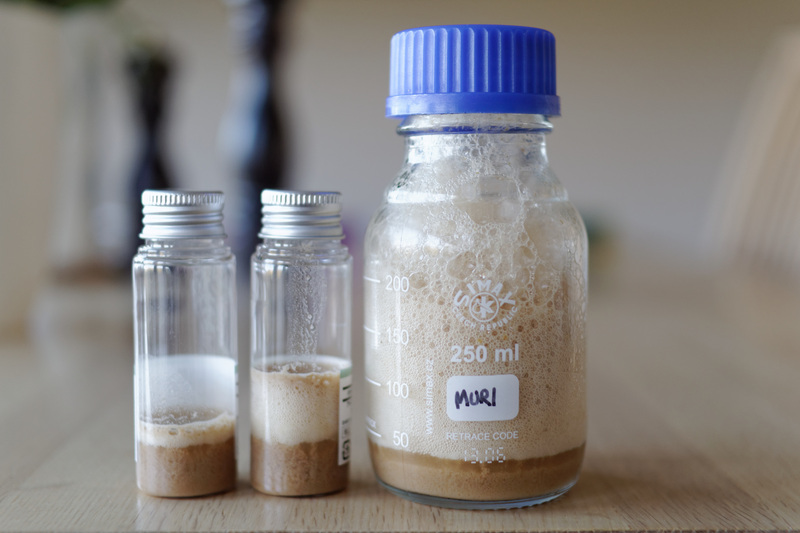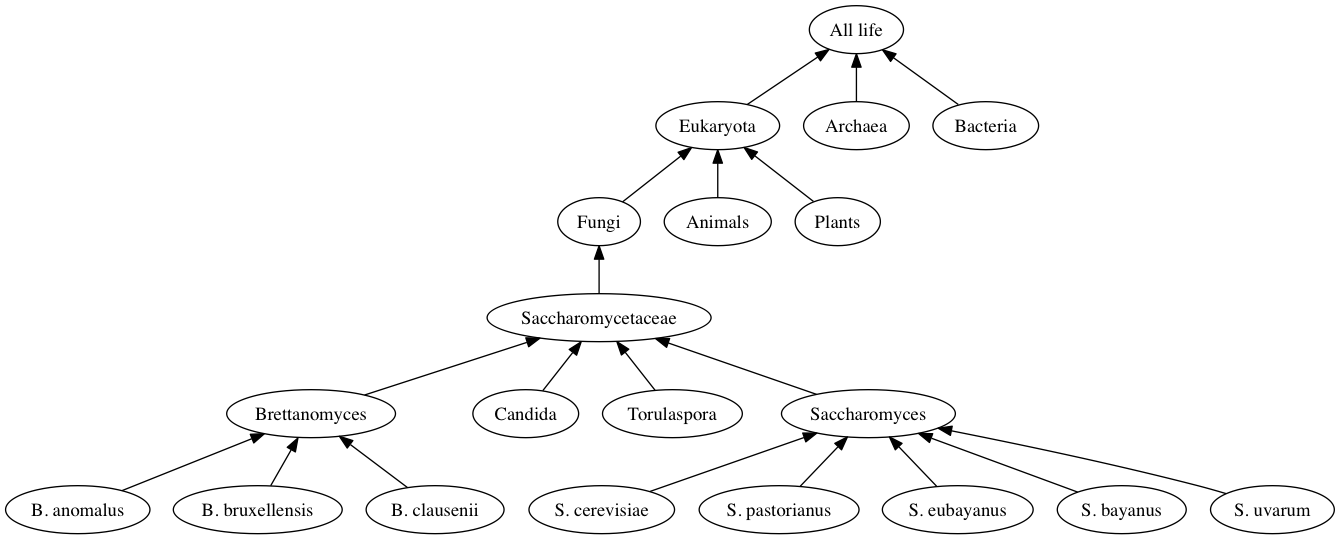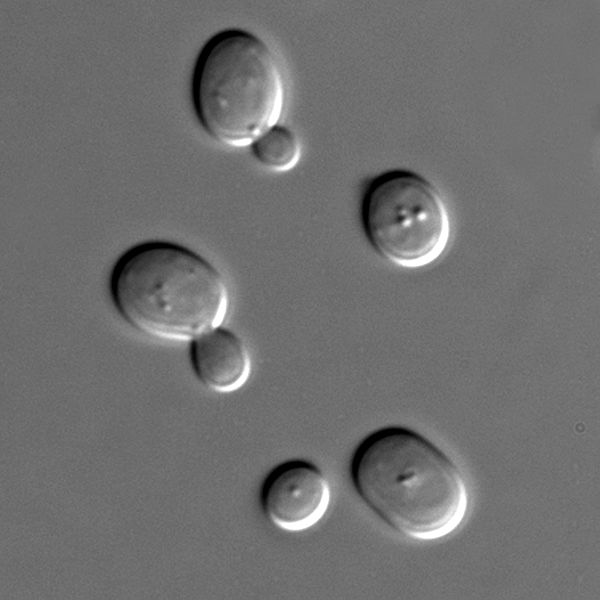Yeast terminology, part 1

Yeast culture (in this case WLP 6788) |
I was asked to explain the family trees of yeast and since not much has been written on this I figured I'd give it a go. Before we get to the actual family tree, let's start by clearing up some terminology.
If I collect a glass of kveik from a brewer, that's not actually a kveik strain. It's really a culture, a mix of millions and millions of microorganisms, together with protein sludge, hop remains, and so on. If you buy a vial of lab yeast that vial also contains a culture, but since the culture almost always consists of exactly one strain of yeast you can think of the vial as containing a specific yeast strain. With kveik that doesn't work any more, hence the need for more precise vocabulary.
Biologists have developed a huge taxonomy of all living creatures based on the work of Linnaeus, which we'll get to below, but that taxonomy stops at the species level. So using that terminology we can divide brewing yeasts into Brettanomyces, ale yeast, and lager yeast, for example. All ale yeast belongs to the same species, so hefeweizen yeast and saison yeast are both Saccharomyces cerevisiae. This is why we have the concept of a strain. All yeast in the same strain are genetically identical, and genetically different from other strains. Of course, there's more than a single strain of saison or hefeweizen yeast.
Now, let's turn to the biological taxonomy.

Yeast family tree |
Let's start at the top. The most commonly accepted division of living creatures today splits all life into three so-called domains: bacteria, archaea, and eukaryota. Archaea are single-celled creatures that were originally thought to be bacteria, but which differ from them in a number of ways. They are fascinatingly weird, but irrelevant for our purposes here.
Bacteria you already know. They have a very primitive structure which is basically just a cell wall with everything else floating around freely inside. Eukaryota differ from them in that their cells contain more complex organs, such as the cell nucleus and mitochondria. While the grouping "eukaryota" is not very well known, it contains just about every kind of living creature you ever heard of, except bacteria. Yeast, human beings, and oak trees are all eukaryotes. Which actually means that beer yeast is more closely related to you than it is to bacteria. We'll return to bacteria in more detail in a later blog post.
In the tree above only the names in the bottom row are actually species. The naming system that Linnaeus devised for species uses two-part names, like Homo sapiens (that's us), or Saccharomyces cerevisiae. The first part is called the genus, and is the group name for a group of closely related species. All species in the same genus have the same first name, but different second names. Hence Homo sapiens, Homo erectus, Homo habilis, and so on. And Saccharomyces cerevisiae, Saccharomyces pastorianus, and so on.
People tend to think that they divide animals into species, but research on "primitive" peoples show that when prompted they tend to naturally identify creatures at the genus level, even though they are well aware of the separation into species. "Modern" humans also focus on the genus, and tend to forget the existence of species, although sometimes what we think of as species really is species.
Oak is in fact a genus, divided into species like white oak, Hungarian oak, Turkey oak, canyon live oak, and so on. Juniper is another genus, divided into common juniper, shore juniper, temple juniper, etc. Gorilla is also a genus, with two species: eastern and western gorilla. Lion (Panthera leo) and tiger (Panthera tigris) really are species, however. (As for what defines a species, I wrote about that a long time ago.)

Saccharomyces cerevisiae (by Masur) |
But back to the yeasts. Yeast is one subdivision below domain, that is, a "kingdom", with the name "Fungi". At the moment there are 1500 different named species (and probably many more that are not named yet), including the mushrooms you find in the forest, molds, and single-celled yeasts. Unfortunately, these categories, which are based on what we humans can see without microscopes, match the actual taxonomy rather poorly, so I'll skip the Latin in this case.
The single-celled yeasts that reproduce by budding are all collected in the family Saccharomycetaceae. Here we find Brettanomyces, Candida (which often live in humans, and sometimes cause infections), Saccharomyces, Torulaspora, and others.
Let's start with Brettanomyces. As you can see, they're a genus, and pretty close to the true beer yeast. A weird thing about this genus is that it also has another name: Dekkera. These yeasts have a life cycle where they sometimes reproduce sexually and sometimes asexually. The two cycles appear pretty different in the microscope, and so a single set of species got two sets of names based on their appearance. But they are all the same. So each species within the genus Brettanomyces has an alternative name starting with Dekkera. Thus, Brettanomyces anomalus = Dekkera anomalus, Brettanomyces bruxellensis = Dekkera bruxellensis, and so on through the whole list of species within the genus.
Brettanomyces is used in beer brewing and wine production, but has also been found in feta cheese and in sourdough, and limited amounts are considered desirable in sour dough and kombucha tea. In wine it's sometimes considered an infection. It has been claimed that in beer Brettanomyces produces more 4-ethylguiacol (clove, spicy smell) than 4-ethylphenol (medicinal aroma), but that in wine this is the other way around. That makes me wonder why Brettanomyces is sometimes considered desirable in wine, so probably this is not the full story. (If you want to learn about the brewing characteristics, read this.)

Brewers' Hall, where Hjelte Claussen gave his talk (print by W. Radcliffe, 1831) |
The discovery of Brettanomyces is an interesting story. After Emil Chr. Hansen developed the system for purifying a yeast culture so that it consisted of only a single strain in 1883, his system spread across Europe and North America like wildfire. With one exception: the UK. Brewers there found that the Hansen system did not work for them. Specifically, the problem was with matured beers, which did not develop the right flavours.
In 1904 N. Hjelte Claussen, of the Carlsberg Laboratory, presented a paper in London where explained that he had discovered the cause of this problem. The cause was that English brewers used a culture with yeast of two different species in it. Both the familiar Saccharomyces cerevisiae, but also a so far unknown yeast which Hjelte Claussen decided to call Brettanomyces (British fungus).
Hjelte Claussen explains that if you take a pasteurized beer, and add a few drops of Brettanomyces in wort, then leave the bottle relatively warm for 10-14 days, it will get what he calls "an unmistakable English character." He also describes a few more experiments that make it abundantly clear that Brettanomyces is what is responsible for the character of matured English beer. It's a very clear and interesting paper, and I recommend reading both it and the summary of the ensuing discussion with British brewers.
So, to recap quickly, Brettanomyces is a genus, not a species. There are several Brettanomyces species, and each of those in turn has a number of strains. So saying Brettanomyces does this or does that is often a complicated proposition, because there's a huge range of Brettanomyces strains and they are not all the same.
This leaves the Saccharomyces family, which we'll return to in a later post, because this one is already plenty long enough. We'll also return to the bacteria. (Part 2: bacteria.)
Similar posts
Yeast terminology, part 2: bacteria
We continue the series on the family tree of yeast with a post on bacteria
Read | 2015-09-05 15:28
Where kveik comes from
I've written before about the kveik research paper by Preiss, Tyrawa, and van der Merwe
Read | 2018-09-12 16:27
The Saccharomyces family
The series on yeast taxonomy now ends with a post on the various species in the Saccharomyces family
Read | 2015-10-17 12:19
Comments
Nice - 2015-08-27 17:04:10
Something to look forward to :).
noor - 2024-08-27 23:56:47
hi! i was wondering how i can cite this blog for a science project?
Lars Marius - 2024-08-28 09:24:17
@Noor: Here is a good guide on how to cite blog posts: https://www.topuniversities.com/blog/how-properly-cite-blog-your-essay
John Rewman - 2025-03-25 00:55:14
I believe Hjelte Claussen was wrong about the pasteurized beer. I find 20 days or so instead of 10-14 gives it a much better taste, and certainly more of "an unmistakable English character".